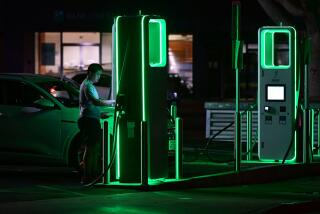Don’t Let Rental Cars Take You for a Ride
Like the rest of the travel industry, the auto rental companies are experiencing a softening in demand for their product. Yet it’s still possible to be victimized by ridiculously high rental rates unless you use a few key strategies:
* Get a competing quote from the Web. Typing “car rental” into any search engine will bring you to booking engines that can frequently save you significant money. Travelocity, Expedia, Orbitz, Priceline and other major travel sites all have car rental areas, and others, such as BreezeNet (www.bnm.com), are clearinghouses for independent auto rental agencies around the country.
* Go for the subcompacts. Not only are these naturally the cheapest models on the lot, but surprisingly often they will be sold out when you arrive to claim the car, so you may be upgraded--for free--to the next size. Even if the agency has subcompacts on hand, it can’t hurt to ask for the upgrade at subcompact rates.
* Consider locations outside the airport. The same car that would cost you $49 a day at the airport might run you $35 at a downtown or other location, and you can usually get there by inexpensive public transportation, on a free shuttle or at most for a one-time taxi fare. And you can return the car at the airport and keep that same lower rate.
* Leave town. In a few cities, most notoriously New York, car rental rates can get exorbitant. A subcompact that would cost $69 a day in Manhattan, though, might cost only $39 in North White Plains, a suburb of New York City; you can get there on the Metro North commuter railroad for $6.50 each way. And you can return the car in Manhattan for the lower rate.
* Check the weekly rate. Oddly enough, sometimes weekly rates can be cheaper than three-day rentals.
* Join frequent-renter clubs. Operated by the major car rental companies and bearing names like “Gold Service” and “Emerald Club,” the clubs are free to join and usually net discounts of at least 5% on each rental. Sometimes a program like Avis Wizard can save you as much as 15%. Other perks: Some clubs allow you to earn points toward future free rentals, and often they get you better service too.
* Fill ‘er up before returning. Plan your last day using the car so that you never have to return it with less gas in the tank than it had when you got it. Often fuel surcharges can double or triple the price per gallon that you would pay at a regular gas station. And don’t worry about filling it up right outside the rental office; in some cases the gas tank needle will stay at “F” for as much as 45 minutes in traffic.
* Avoid duplicating insurance. Rental companies may try to sell you additional insurance, including liability (sometimes called liability insurance supplement), accident (a.k.a. personal accident insurance) and policies covering your belongings. You undoubtedly have health insurance, and probably homeowners’ and auto insurance, so you can often decline them all; that several dollars a day adds up fast. Even if you don’t have homeowners’, it’s mostly a waste of money unless you’re transporting the crown jewels.
* Avoid paying for unnecessary collision damage waivers. Also known as loss damage waivers, they’ll add more than $9 a day to your rental cost unless you sign the agreement making you responsible for damage. Many states have outlawed this liability by requiring car rental companies to pay for collision insurance, so you don’t have to worry. But even if you rent in a state that allows CDW (collision damage waiver) charges, you can avoid the hefty fees by using a credit card that covers collision, such as American Express, and bank cards such as MBNA America Visa and MasterCard. (Not all bank cards do, though, so check yours ahead of time.)
More to Read
Sign up for The Wild
We’ll help you find the best places to hike, bike and run, as well as the perfect silent spots for meditation and yoga.
You may occasionally receive promotional content from the Los Angeles Times.






